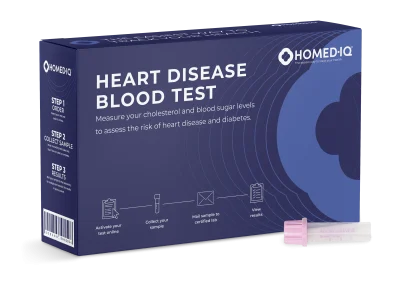Triglycerides are a type of fat that plays a vital role in your body, acting as an energy source and providing insulation for your organs. However, when these fats are out of balance, they can become a significant health risk. While some fat in the body is necessary, having too much or too little triglycerides can impact your heart and overall health. In this article, we’ll explore what triglycerides are, why they’re important, and how to keep them in a healthy range to reduce your risk of cardiovascular diseases and other health conditions.
Table of Contents
- What are Triglycerides?
- Why are triglycerides important?
- What is a normal triglyceride level?
- Could your triglycerides level be too high or too low?
- Testing Triglycerides
- How can you raise or lower triglyceride levels?
- Summary
What are Triglycerides?
Triglycerides are fatty substances that enter the body through food or are produced by the liver. When you eat excess calories (in particular carbohydrates) your liver produces triglycerides. Most fats we eat also contain triglycerides, such as butter, oil, and margarine. Triglycerides are stored as fat on the body for later use (Mayo Clinic, 2022).
What is the difference between cholesterol and triglycerides?
Triglycerides and cholesterol are two distinct types of lipids found in the bloodstream:
- Cholesterol helps form cell structures and is essential for producing certain hormones.
- Triglycerides store excess calories and serve as a source of energy for the body.
Source: Mayo Clinic, 2022
Why are triglycerides important?
Triglycerides play several important roles in the body. These include:
- Energy storage: Stored in fat tissue and broken down into fatty acids and glycerol to fuel cells during fasting or exertion.
- Insulation & protection: Provide thermal insulation and cushion vital organs.
- Cellular structure: Support cell membrane integrity and communication.
Keeping triglycerides within a healthy range is essential for overall well-being, particularly heart health. When levels rise too high, they can have serious consequences for the body:
- Cardiovascular risk: Linked to heart disease and stroke, often alongside obesity, insulin resistance, and metabolic syndrome, promoting arterial plaque buildup.
- Pancreatitis: Levels above 1000 mg/dL can trigger acute, potentially life-threatening pancreatitis.
- Metabolic syndrome: A key marker of this condition, which raises the risk of type 2 diabetes and cardiovascular disease.
Source: Hinou, H., 2024
What is a normal triglyceride level?
There is no specific target value for triglycerides. Triglycerides are considered normal when they are below 150 mg/dL or 1.7 mmol/l (Hartstichting, n.d.). In this case, the risk of cardiovascular disease is lowered. The following ranges apply:
| Category | mg/dL Range | mmol/L Range |
|---|---|---|
| Normal | Less than 150 mg/dL | Less than 1.7 mmol/L |
| Borderline High | 150 – 199 mg/dL | 1.8 – 2.2 mmol/L |
| High | 200 – 499 mg/dL | 2.3 – 5.6 mmol/L |
| Very High | 500 mg/dL or above | 5.7 mmol/L or above |
Source: Mayo Clinic, 2022
Could your triglycerides level be too high or too low?
| Triglyceride Level | Category | Diseases Related to Elevated/Low Triglycerides |
|---|---|---|
| Above 3.0 mmol/l | High Triglycerides | Heart disease, type 2 diabetes, liver disease, kidney disease, pancreatitis, thyroid disorders. |
| Below 0.8 mmol/l | Low Triglycerides | Stroke, malnutrition, hyperthyroidism, digestive disorders. |
Source: American Academy of Neurology, 2007.
What Causes Elevated Triglycerides?
Several factors can contribute to high triglyceride levels:
- Diabetes: Uncontrolled blood sugar levels can increase triglycerides.
- Overweight: Excess weight often correlates with high triglycerides.
- Unhealthy Diet: Diets high in sugar, refined carbohydrates, and unhealthy fats raise triglyceride levels.
- Excessive Alcohol: Drinking too much alcohol is a major risk factor for elevated triglycerides.
- Genetics: Some people are genetically predisposed to high triglycerides.
Source: National Heart, Lung, and Blood Institute, 2023
What Causes Low Triglycerides?
Low triglyceride levels can be caused by several factors, including:
- Poor nutrition: Low intake of fats and carbohydrates.
- Malabsorption: Impaired nutrient absorption in the intestines.
- Liver disease: Reduced triglyceride production.
- Hypermetabolic states: Increased energy demands (e.g., hyperthyroidism, burns, intense activity).
- Genetic factors: Rare inherited disorders.
If you have low triglycerides, it’s important to investigate the underlying cause so that appropriate measures can be taken.
Source: National Heart, Lung, and Blood Institute, 2023
Testing Triglycerides
It is wise to test triglycerides if there is diabetes. This is because patients with diabetes usually have too high a level of triglycerides. It is of course also possible to perform the test if you suspect, for example because of your lifestyle or complaints, that you may be at risk of developing cardiovascular disease.
Testing triglycerides is possible as a part of Homed-IQ’s Heart Disease Blood Test. This home test is simple to perform, using only a finger prick to obtain a blood sample. In addition to determining the triglyceride value, this test includes an analysis of blood sugar and cholesterol levels. After mailing your test, a certified laboratory will examine your sample and a laboratory report will be sent to you.
-

Heart Disease Blood Test
€55,00
How can you raise or lower triglyceride levels?
Treatment for High Triglycerides
- Diet: Reduce saturated/trans fats, processed foods, refined carbs, and sugary drinks; focus on whole grains, fruits, vegetables, and healthy fats.
- Exercise: Aim for 150 min/week of moderate or 75 min/week of vigorous activity (consult your doctor).
- Weight management: Maintain a healthy weight to lower triglyceride levels.
- Medication: Statins, fibrates, niacin, or omega-3 supplements may be prescribed if lifestyle changes aren’t enough.
Treatment for Low Triglycerides
- Diet: Increase healthy fats (olive oil, avocado, omega-3-rich fish) while limiting refined carbs and ensuring balanced nutrition.
- Exercise: Regular physical activity helps regulate triglyceride levels, tailored to whether they are high or low.
- Medication: If caused by conditions like liver disease or malabsorption, doctors may prescribe targeted treatments.
Source: National Heart, Lung, and Blood Institute, 2023
Summary
Triglycerides are essential fats used by the body for energy, but an imbalance—whether too high or too low—can lead to serious health issues. High triglyceride levels can increase the risk of heart disease, type 2 diabetes, liver disease, and more, while low levels may indicate problems such as malnutrition or thyroid dysfunction. Maintaining healthy triglyceride levels is key to good cardiovascular health, and lifestyle changes like a healthier diet, exercise, and reducing alcohol can help manage these levels. Testing triglycerides, especially if you’re at risk, is a simple way to monitor your health and take early action.
References
American Academy of Neurology. (2007, December 26). High triglycerides, other cholesterol raise risk of stroke [Press release]. AAN. Retrieved August 29, 2025, from https://www.aan.com/PressRoom/home/PressRelease/569
Hartstichting. (n.d.). Cholesterol: alles over de verschillende soorten en waarden. Retrieved August 29, 2025, from https://www.hartstichting.nl/oorzaken/cholesterol?tab=1
Hinou, H. (2024). Triglycerides: Its functions, health implications and their significance in maintaining optimal levels. Journal of Glycomics & Lipidomics, 13, Article 361. https://doi.org/10.35248/2153-0637.24.13.361
Mayo Clinic Staff. (2022, March 3). Triglycerides: Why do they matter? Mayo Clinic. Retrieved August 29, 2025, from https://www.mayoclinic.org/diseases-conditions/high-blood-cholesterol/in-depth/triglycerides/art-20048186
National Heart, Lung, and Blood Institute. (2023, April 19). High blood triglycerides. NIH. Retrieved August 29, 2025, from https://www.nhlbi.nih.gov/health/high-blood-triglycerides





